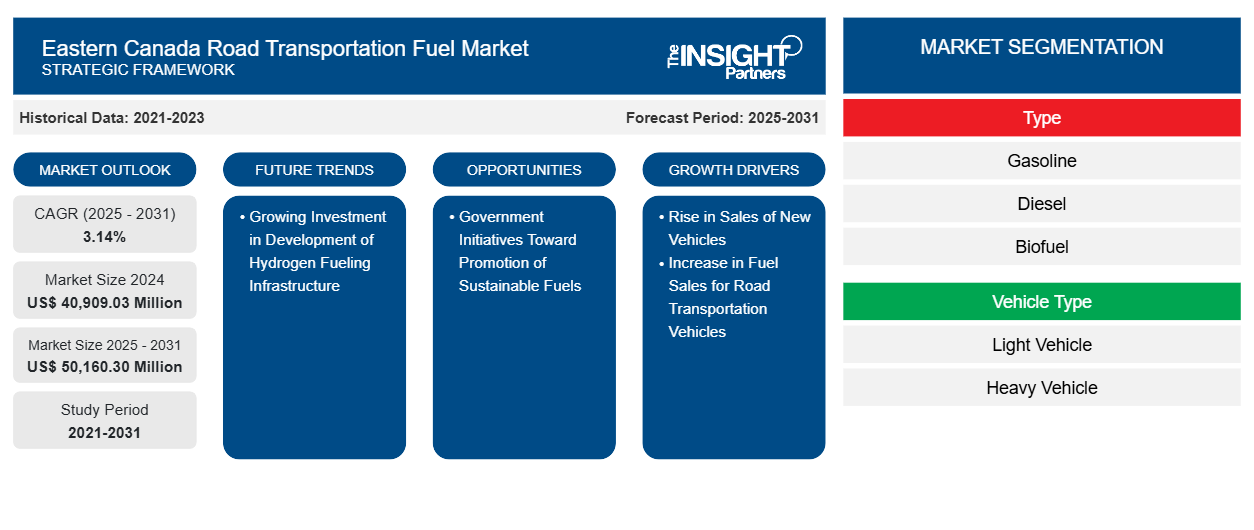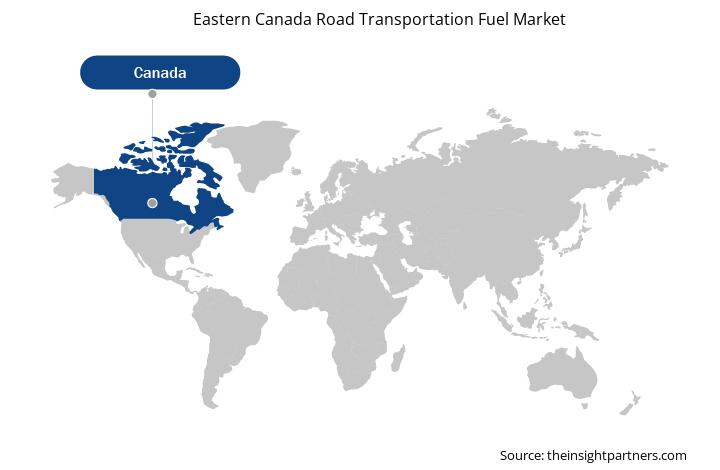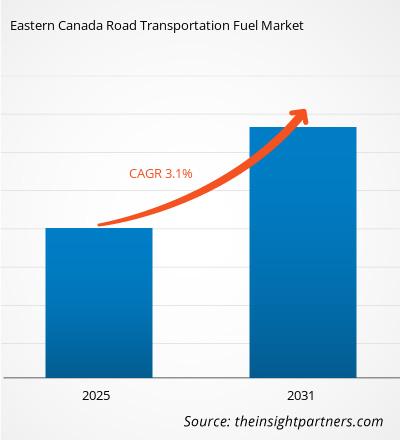カナダ東部の道路輸送燃料市場規模は、2024年の409億903万米ドルから2031年には501億6030万米ドルに達すると予測されています。市場は2025年から2031年にかけて3.14%の年平均成長率(CAGR)を記録すると予測されています。輸送業界への投資の増加は、今後数年間で市場に新たなトレンドをもたらす可能性が高いでしょう。CAGR of 3.14% during 2025–2031. The growing investments in the transportation industry are likely to bring new trends to the market in the coming years.
東カナダ道路輸送燃料市場分析
輸送燃料はカナダ経済において重要な役割を果たしています。カナダ東部の輸送燃料市場エコシステムにおける主要なステークホルダーには、製油所、輸送燃料販売業者・小売業者、そして最終消費者が含まれます。主要な最終消費者には、旅客輸送車両と貨物輸送車両が含まれます。道路輸送は、貨物輸送と人輸送に分類されます。輸送燃料は、様々な輸送手段で使用される内燃機関を駆動するエネルギー源です。輸送部門には、人や貨物の移動に使用される道路(自動車、トラック、バスを含む)、鉄道、海上、航空輸送が含まれます。輸送部門はエネルギー消費量の約20%を占め、カナダにおける最大の石油消費部門です。輸送燃料は、抽出されたエネルギー資源を利用可能な製品に変換する精製プロセスによって生成されます。液体燃料は、主要な燃料源の化学的特性によって異なります。現在、輸送燃料の80%以上は石油由来です。オンタリオ州とケベック州は、これらの州に道路輸送燃料の消費者が多数存在するため、カナダ東部の道路輸送燃料市場に大きな影響を与えています。
東カナダ道路輸送燃料市場の概要
カナダにおける自動車の生産と販売の増加は、道路輸送燃料市場の成長を牽引しています。さらに、道路輸送車両向け燃料販売の増加は、東カナダの道路輸送市場の成長を牽引しています。さらに、道路輸送用途における持続可能な燃料の推進に向けた政府の取り組みは、2025年から2031年にかけて市場の成長を牽引すると予想されています。さらに、水素燃料インフラの開発への投資増加は、予測期間中の市場の主要なトレンドになると予測されています。
東カナダの道路輸送燃料市場を牽引する主要産業には、運輸・物流、建設、鉱業、石油・ガス、ヘルスケア、電子商取引などがあります。カナダ燃料協会によると、カナダ全土で年間約2億リットルの燃料が車両の燃料タンクに汲み上げられています。カナダには16の石油精製所、75の燃料配給ターミナル、12,000以上の小売店と商業施設があります。さらに、カナダ政府は州政府と協力して、カナダの将来の燃料ミックスとエネルギー移行の目標を達成するために、代替燃料または持続可能な燃料の推進を目指しました。カナダの消費者の大型車への嗜好の高まりは、ガソリンとディーゼルの需要に大きな影響を与え、それが今度はカナダの市場成長を牽引すると予測されています。
カナダ東部の道路輸送燃料市場の最終ユーザーには、小型車両と大型車両が含まれます。これらの車両は、カナダ全土で旅客輸送および貨物輸送に使用されています。この地域における新車登録台数の増加は、今後数年間の道路輸送燃料の需要を押し上げると予想されています。物流、eコマース、製造業、建設セクターの成長に牽引され、カナダ東部における道路輸送を通じた貿易活動が増加していることから、2025年から2031年にかけて道路輸送燃料の需要が増加すると予想されます。
このレポートの一部、国レベルの分析、Excelデータパックなど、あらゆるレポートを無料でカスタマイズできます。また、スタートアップや大学向けのお得なオファーや割引もご利用いただけます。
カナダ東部の道路輸送燃料市場:戦略的洞察

-
このレポートの主要な市場動向を入手してください。この無料サンプルには、市場動向から見積もりや予測に至るまでのデータ分析が含まれます。
東カナダの道路輸送燃料市場の推進要因と機会
道路輸送車両向け燃料販売の増加
近年、カナダではトラック燃料の販売が大幅に増加しています。この増加は、経済情勢と消費者の嗜好の変化を反映した様々な要因によるものです。これは、カナダ経済において重要な役割を果たす運輸部門における、より広範な動向を浮き彫りにしています。カナダはCOVID-19パンデミックの影響からの回復を続けており、経済活動が顕著に回復し、燃料需要の増加につながっています。事業活動の再開と消費者の旅行の増加が相まって、特にガソリンとディーゼル燃料の消費量が増加しています。さらに、乗用車、トラック、商用車を含む車両登録台数の増加も、燃料販売の増加に貢献しています。カナダ人が旅行やビジネスを行うにつれて、道路輸送に使用される燃料の需要も急増しています。
持続可能な燃料の推進に向けた政府の取り組み
世界が2050年までにネットゼロエミッション(NZE)達成に向けた取り組みを強化する中、炭素削減とゼロエミッション燃料の生産への大きな転換が進むでしょう。カナダは、消費者が現在求めている、そして将来ますます求めるであろうこれらの燃料の生産者および消費者となる立場にあります。クリーン燃料規制は、持続可能な燃料、技術、およびプロセスの開発と導入に対するインセンティブを強化します。クリーン燃料規制の目標は、クリーン燃料を徐々にクリーン化することで、汚染を大幅に削減することです。クリーン燃料規制は、液体化石燃料(ガソリンおよびディーゼル)の供給業者に対し、カナダ国内での使用を目的として生産・販売する燃料の炭素強度(または汚染量)を段階的に削減することを義務付けています。これは、2030年までにカナダで使用されるガソリン燃料とディーゼル燃料の炭素排出原単位が約15%(2016年レベル以下)削減されることを意味します。国際エネルギー機関(IEA)とカナダ先進バイオ燃料協会(Advanced Biofuels Canada)によると、バイオディーゼルの総生産量は2021年の4億3,100万リットルから2023年には4億9,600万リットルに増加すると予想されています。さらに、バイオディーゼルの消費量も2021年の4億1,200万リットルから5億2,500万リットルに増加しました。したがって、持続可能な燃料の推進に向けた政府の取り組みは、予測期間中に東カナダの道路輸送燃料市場で事業を展開する主要企業にとって機会を生み出すと期待されます。
東カナダ道路輸送燃料市場レポートのセグメンテーション分析
東カナダの道路輸送燃料市場分析の導出に貢献した主要なセグメントは、タイプと車両タイプです。
- 種類別に見ると、市場は ガソリン、ディーゼル、バイオ燃料、天然ガス、その他に分類されます。2024年にはガソリンセグメントが市場を支配しました。
- 車両の種類に基づいて、市場は軽自動車と大型自動車に分けられます。2024年には軽自動車セグメントが市場を支配しました。
カナダ東部道路輸送燃料市場シェア分析(地域別)
カナダ東部の道路輸送燃料市場は、オンタリオ州、ケベック州、沿海地方、その他という4つの主要州に区分されています。2024年にはオンタリオ州が市場を支配し、次いでケベック州と沿海地方が続きました。
カナダ統計局の分析によると、乗用車の新車登録台数は2021年の93,867台から2023年には67,788台に減少しました。また、ガソリン車の登録台数は2022年の295,288台から2024年の288,324台に減少し、ディーゼル車の販売台数は2022年の15,278台から2024年の15,860台に増加しました。ガソリン車の販売台数の減少は、この地域でのゼロエミッション車の導入に対する需要の増加と政府の取り組みに起因しています。例えば、ケベック州では、ゼロエミッション車の導入に向けた政府の取り組みが増加したため、すべてのタイプのゼロエミッション車の販売台数は2022年の45,881台から2024年には147,507台に増加しました。ケベック州は2024年12月、2035年までにケベック州内のすべての新型軽量内燃エンジン車の販売を禁止する規制を採択し、2035年までに排出ガス100%の車という目標を達成しました。さらに、道路自動車で使用される液化石油ガス(LPG)の純売上高は、2021年の7,484万リットルから2023年には1億1,820万リットルに増加しました。したがって、ケベック州の道路輸送部門からの燃料消費量の増加は、2025年から2031年にかけて市場の成長を牽引すると予想されます。
東カナダ道路輸送燃料市場地域分析
予測期間全体を通して東カナダ道路輸送燃料市場に影響を与える地域的な傾向と要因は、Insight Partnersのアナリストによって徹底的に説明されています。このセクションでは、東カナダ道路輸送燃料市場のセグメントと、北米、ヨーロッパ、アジア太平洋、中東・アフリカ、中南米における地域についても説明します。

- 東カナダの道路輸送燃料市場の地域別データを入手
東カナダ道路輸送燃料市場レポートの範囲
| レポート属性 | 詳細 |
|---|---|
| 2024年の市場規模 | 409億903万米ドル |
| 2031年までの市場規模 | 501億6030万米ドル |
| 世界のCAGR(2025年~2031年) | 3.14% |
| 履歴データ | 2021-2023 |
| 予測期間 | 2025~2031年 |
| 対象セグメント |
タイプ別
|
| 対象地域と国 |
カナダ東部
|
| 市場リーダーと主要企業の概要 |
|
東カナダ道路輸送燃料市場のプレーヤー密度:ビジネスダイナミクスへの影響を理解する
カナダ東部の道路輸送燃料市場は、消費者の嗜好の変化、技術の進歩、製品の利点に対する認知度の高まりといった要因によるエンドユーザーの需要増加に牽引され、急速に成長しています。需要の増加に伴い、企業は製品ラインナップの拡充、消費者ニーズへの対応のための革新、そして新たなトレンドの活用を進めており、これが市場の成長をさらに加速させています。
市場プレーヤー密度とは、特定の市場または業界内で事業を展開する企業または会社の分布を指します。これは、特定の市場空間における競合企業(市場プレーヤー)の数が、その市場規模または市場価値全体と比較してどれだけ多いかを示します。
カナダ東部道路輸送燃料市場で事業を展開している主要企業は次のとおりです。
- シェブロン・オロナイト社
- サンコア・エナジー社
- バレロ・エナジー・コーポレーション
- エクイノールASA
- エクソンモービル社
- 中国海洋石油有限公司
免責事項:上記の企業は、特定の順序でランク付けされているわけではありません。

- 東カナダ道路輸送燃料市場の主要な主要プレーヤーの概要を入手
東カナダ道路輸送燃料市場のニュースと最近の動向
カナダ東部の道路輸送燃料市場は、主要な企業出版物、協会データ、データベースを含む一次調査および二次調査に基づく定性・定量データの収集によって評価されています。カナダ東部の道路輸送燃料市場における主要な動向をいくつか以下に挙げます。
- TotalEnergies Marketing Canada Inc.は、カナダのWajax社との戦略的パートナーシップを発表しました。このパートナーシップにより、工業、林業、建設、鉱業、輸送などの分野における様々な用途のニーズに応える潤滑油とTotalEnergiesの幅広いポートフォリオへのアクセスを提供します。(出典:TotalEnergies Marketing Canada Inc.、プレスリリース、2024年9月)
- シェブロン社は、再生可能燃料の新たな製造方法を追求しています。同社は、低炭素社会の実現に向けて、新たな炭素利用の道を模索しています。シェブロン社は現在、回収した二酸化炭素(CO2)を持続可能な航空燃料、メタノール、その他の低炭素強度燃料に変換する革新的な触媒の活用方法を研究しています。(出典:シェブロン社、プレスリリース、2024年8月)
東カナダ道路輸送燃料市場レポートの対象範囲と成果物
「東カナダ道路輸送燃料市場規模と予測(2021〜2031年)」では、以下の分野を網羅した市場の詳細な分析を提供しています。
- 東カナダの道路輸送燃料市場の規模と予測(州レベル)
- 東カナダの道路輸送燃料市場の動向、および推進要因、制約、主要な機会などの市場動向
- 詳細なPEST分析とSWOT分析
- 主要な市場動向、地域および州の枠組み、主要プレーヤー、規制、最近の市場動向を網羅したカナダ東部の道路輸送燃料市場分析
- 市場集中、ヒートマップ分析、主要プレーヤー、東カナダの道路輸送燃料市場の最近の動向を網羅した業界の展望と競争分析
- 詳細な企業プロフィール
- 過去2年間の分析、基準年、CAGRによる予測(7年間)
- PEST分析とSWOT分析
- 市場規模価値/数量 - 世界、地域、国
- 業界と競争環境
- Excel データセット
最新レポート
お客様の声
購入理由
- 情報に基づいた意思決定
- 市場動向の理解
- 競合分析
- 顧客インサイト
- 市場予測
- リスク軽減
- 戦略計画
- 投資の正当性
- 新興市場の特定
- マーケティング戦略の強化
- 業務効率の向上
- 規制動向への対応






















 無料サンプルを入手 - 東カナダ道路輸送燃料市場
無料サンプルを入手 - 東カナダ道路輸送燃料市場